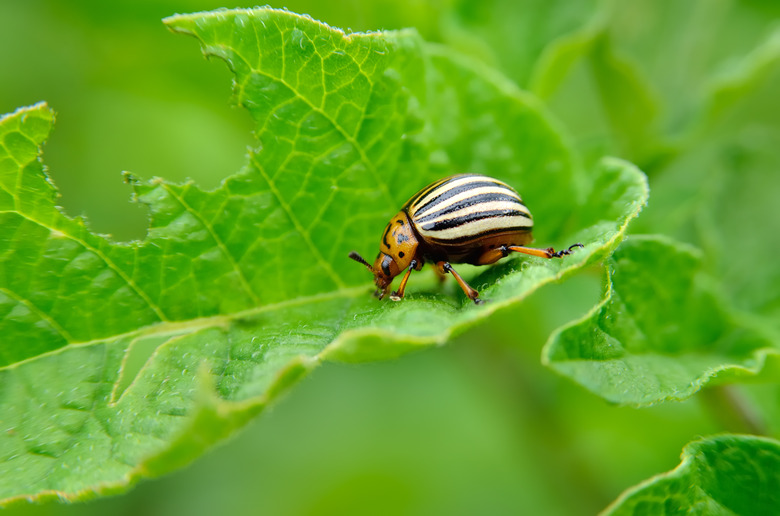What Are Potato Bugs?
The name potato bug refers to two different insects: the Jerusalem cricket and the Colorado potato beetle. The Jerusalem cricket, or Stenopelmatus fuscus, is a wingless insect. The Colorado potato beetle, or Leptinotarsa decemlineata, is an insect pest of the nightshade, or Solanaceae, family of flowering plants. Both Jerusalem crickets and Colorado potato beetles are distinguished by certain characteristics, including appearance, distribution, diet and pest management.
An Alien Appearance
An Alien Appearance
Potato bugs have an eerily alien look about them. Known for their disproportionately large, human-like heads and big jaws, Jerusalem crickets can reach up to 2 or 2 1/2 inches long and typically have amber-yellow legs, heads and thoraxes. Their abdomens alternate with black and brown bands, and they use their spiny legs for digging in the soil.
Colorado potato beetles measure about 3/8 inches long. They are oval and have hard, yellowish-orange outer wings with 10 black vertical stripes. In their newly hatched larva form, the beetles have black heads and soft red bodies.
Distribution and Habitat
Distribution and Habitat
Jerusalem crickets are found in the western and southwestern parts of the United States and along the Pacific coast. They range from British Columbia in the north to Mexico in the south. The insects are nocturnal and mostly live in the ground. They can also be found crawling about above ground, hiding under rocks or residing in manure heaps and damp places.
Colorado potato beetles inhabit most parts of the United States except for California, Alaska, Nevada and Hawaii. They also are found in Europe and parts of Asia. The beetles spend the winter in the soil and then lay eggs on the underside of their host leaves in the spring.
A Potato Bug's Menu
Jerusalem crickets and Colorado potato beetles are called potato bugs because of their diets. Jerusalem crickets can sometimes be found in potato fields eating the roots and tubers of potato crops. While the crickets have occasionally damaged commercial potato fields, they are not considered serious pests. They prefer to eat a variety of meats, small insects, fruits, roots and tubers. Colorado potato beetles are serious pests that feed on potato leaves. The beetles prefer to eat potato crops, but they are also known to eat and destroy tomato, pepper and eggplant crops. Female potato beetles lay their eggs on the underside of potato leaves, and larvae feed on the leaves when they hatch.
Crop Damage and Mitigation
Crop Damage and Mitigation
Jerusalem crickets can cause serious crop damage if they appear in large numbers. Farmers typically control them through physical removal and disposal, baiting and trapping and the use of insecticides. It also pays to remove from the vicinity any outdoor objects under which the insects may hide, including lumber, rocks and woodpiles.
Colorado potato beetles can be managed through crop rotation: planting a non-nightshade crop the following year after planting a potato crop. Other methods of control include carefully handpicking the beetles or eggs from plants, using chemical insecticides to kill the insects or using other insects, such as the spiny soldier bug, to eat the larvae and eggs of the Colorado potato beetle. Another natural enemy of potato bugs include birds from the shrike family, which use thorny bushes or barbed-wire fences to remove the head from the bug's body.
References
- University of Nevada, Reno Cooperative Extension; The Jerusalem Cricket; Wayne S. Johnson, Ph.D., et al.
- Orkin: Jerusalem Crickets: Facts, Identification and Control
- University of Tennessee Institute of Agriculture; Vegetable Pests: Colorado Potato Beetle; Frank A. Hale, Ph.D., et al.
- University of Florida Department of Entomology and Nematology; Colorado Potato Beetle; Richard L. Jacques, Jr., et al.; 2009
- Cornell Lab of Ornithology: All About Birds
Cite This Article
MLA
Drake, Julia. "What Are Potato Bugs?" sciencing.com, https://www.sciencing.com/potato-bugs-10003062/. 23 April 2018.
APA
Drake, Julia. (2018, April 23). What Are Potato Bugs?. sciencing.com. Retrieved from https://www.sciencing.com/potato-bugs-10003062/
Chicago
Drake, Julia. What Are Potato Bugs? last modified March 24, 2022. https://www.sciencing.com/potato-bugs-10003062/
